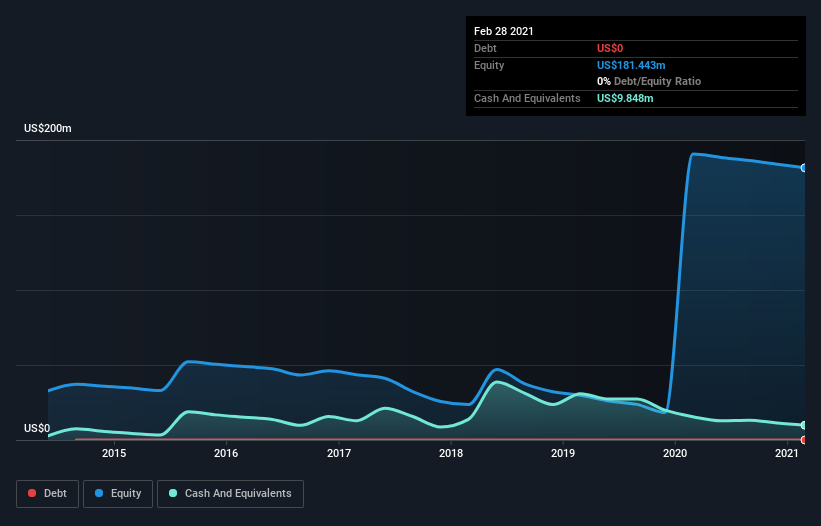We're Interested To See How Trilogy Metals (TSE:TMQ) Uses Its Cash Hoard To Grow
Just because a business does not make any money, does not mean that the stock will go down. For example, although Amazon.com made losses for many years after listing, if you had bought and held the shares since 1999, you would have made a fortune. But while history lauds those rare successes, those that fail are often forgotten; who remembers Pets.com?
Given this risk, we thought we'd take a look at whether Trilogy Metals (TSE:TMQ) shareholders should be worried about its cash burn. For the purpose of this article, we'll define cash burn as the amount of cash the company is spending each year to fund its growth (also called its negative free cash flow). The first step is to compare its cash burn with its cash reserves, to give us its 'cash runway'.
See our latest analysis for Trilogy Metals
When Might Trilogy Metals Run Out Of Money?
You can calculate a company's cash runway by dividing the amount of cash it has by the rate at which it is spending that cash. As at February 2021, Trilogy Metals had cash of US$9.8m and no debt. Looking at the last year, the company burnt through US$5.8m. That means it had a cash runway of around 20 months as of February 2021. Importantly, the one analyst we see covering the stock thinks that Trilogy Metals will reach cashflow breakeven in 3 years. Essentially, that means the company will either reduce its cash burn, or else require more cash. Depicted below, you can see how its cash holdings have changed over time.
How Is Trilogy Metals' Cash Burn Changing Over Time?
Because Trilogy Metals isn't currently generating revenue, we consider it an early-stage business. So while we can't look to sales to understand growth, we can look at how the cash burn is changing to understand how expenditure is trending over time. Notably, its cash burn was actually down by 77% in the last year, which is a real positive in terms of resilience, but uninspiring when it comes to investment for growth. While the past is always worth studying, it is the future that matters most of all. For that reason, it makes a lot of sense to take a look at our analyst forecasts for the company.
Can Trilogy Metals Raise More Cash Easily?
While we're comforted by the recent reduction evident from our analysis of Trilogy Metals' cash burn, it is still worth considering how easily the company could raise more funds, if it wanted to accelerate spending to drive growth. Generally speaking, a listed business can raise new cash through issuing shares or taking on debt. One of the main advantages held by publicly listed companies is that they can sell shares to investors to raise cash and fund growth. By looking at a company's cash burn relative to its market capitalisation, we gain insight on how much shareholders would be diluted if the company needed to raise enough cash to cover another year's cash burn.
Trilogy Metals' cash burn of US$5.8m is about 1.5% of its US$391m market capitalisation. That means it could easily issue a few shares to fund more growth, and might well be in a position to borrow cheaply.
How Risky Is Trilogy Metals' Cash Burn Situation?
As you can probably tell by now, we're not too worried about Trilogy Metals' cash burn. In particular, we think its cash burn relative to its market cap stands out as evidence that the company is well on top of its spending. And even though its cash runway wasn't quite as impressive, it was still a positive. Shareholders can take heart from the fact that at least one analyst is forecasting it will reach breakeven. Looking at all the measures in this article, together, we're not worried about its rate of cash burn; the company seems well on top of its medium-term spending needs. Taking an in-depth view of risks, we've identified 1 warning sign for Trilogy Metals that you should be aware of before investing.
If you would prefer to check out another company with better fundamentals, then do not miss this free list of interesting companies, that have HIGH return on equity and low debt or this list of stocks which are all forecast to grow.
This article by Simply Wall St is general in nature. It does not constitute a recommendation to buy or sell any stock, and does not take account of your objectives, or your financial situation. We aim to bring you long-term focused analysis driven by fundamental data. Note that our analysis may not factor in the latest price-sensitive company announcements or qualitative material. Simply Wall St has no position in any stocks mentioned.
Have feedback on this article? Concerned about the content? Get in touch with us directly. Alternatively, email editorial-team (at) simplywallst.com.

